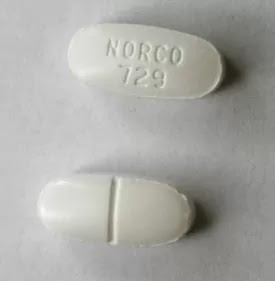
It was just five days. Her prescription was for 20 pills to be taken every six hours. After the doctors in the emergency room couldn’t figure out what was causing the intense pain in her abdomen, they gave her the prescription and told her to go home. It wasn’t appendicitis or any other inflammation, and the CAT scan showed no blockages of any kind. Her pain, which had hit level 9 on a scale of 1 to 10, had no origin they could figure out, so she left the hospital to have the scrip filled.
The Norco worked well for her. As long as she took it every six hours, the pain mostly went away. She ran out of pills on a Monday afternoon and nervously waited for the pain to come back that night. If it reached level 7, she would head back to the ER.
The pain didn’t come back.
On Tuesday morning she followed up with her regular doctor who identified the problem as a fibroid tumor in the uterus (very common and completely benign). The doctor gave her a prescription for a different painkiller, plus another prescription for Norco, just in case.
She briefly mentioned to her doctor that she hadn’t slept well the night before, but didn’t go into detail. She didn’t want to detract from the business of identifying and treating the main problem, but it had been a weird night. She had gone to bed at her usual time, feeling nice and drowsy, but as she closed her eyes and let her body relax into the mattress she suddenly felt the urge to move. She rolled to her other side and adjusted her legs into a new position and sighed back into the pillow. In a second, the feeling of restlessness came back and she began to point her feet and then pull them back into a pointed heel, over and over again, quickly. What was going on? Why did her body feel like this?
When the foot-flexing didn’t bring relief, she rolled onto her back and began kicking her legs against the mattress as if she were doing the back stroke across a pool. This was bizarre! She had heard of restless leg syndrome, but this felt like restless entire body. She felt as if she had suddenly been filled with high octane fuel and needed to burn off energy. Frustratingly, she still felt drowsy and knew she needed to sleep.
She took a Bach flower essence for sleep. She tapped. She listened to a meditation recording. She watched a YouTube ASMR video. Nothing worked. Her body could not unplug from whatever power source was feeding it. She lay in her bed with her eyes closed, with either her legs kicking or other large muscle groups flexing and unflexing. Ten-thirty became 11:30, which became 12:30. Sometimes she got up and walked around for a few minutes, but that just made her exhaustion more obvious. She just wasn’t awake enough to watch a TV show or read a book. She wanted to sleep. Hoping that her grogginess would carry her off, she’d hurry back to the pillow, snuggle into it, but then feel the restlessness overtake her limbs again. She simply could not resist the urge to twist and twitch. It was after 1:00 before her jumpy muscles finally gave in to unconsciousness.
She figured it must be related to the Norco because nothing else in her routine had changed. She went online and learned how addicting the hydrocodone-based drugs are: that they can hook you after just one or two weeks of regular use. She felt horrified by a video that showed changes that happen to the brain when it’s on opioid drugs. She read accounts of addicts trying to quit and the withdrawal symptoms they experienced. One of them was sleeplessness.
“Oh, my god,” she said to herself. “What have I done? There’s no way I’m getting that second Norco prescription filled.” The second night wasn’t as bad and she fell asleep in half the time it had taken on the first night, but she longed for her usual sleep pattern. Please, please let the third night be normal. Or at least the fourth.
During the day she noticed that her sugar cravings were bad. She kept thinking about frosted layer cakes and bakeries and pancake houses. Her research told her that hydrocodone screws with the brain’s ability to regulate serotonin, the hormone that’s critical to a stable mood. If your brain loses its ability to produce serotonin, which opioid drugs can cause, you might find yourself willing to do anything to feel good again. That often means using other drugs like alcohol or heroin. She wondered if Norco messed with appetite if your drug of choice was sugar. She kept wanting to eat even when she wasn’t hungry.
She fed her sugar cravings with fresh fruit, nuts, tea with honey, peanut butter, salads dressed with processed dressing, a Kind bar, and potato salad with sweet relish. Her mood was terrible. If she’d realized that Norco would screw with her careful sugar sobriety, she would have talked to the ER doctors about a different painkiller, but she hadn’t known.
Tonight will be her third night after quitting Norco. She dreads getting in bed and wonders how pill addicts ever manage to kick. She has new sympathy for them.
A friend’s story about Norco, II



0 Comments